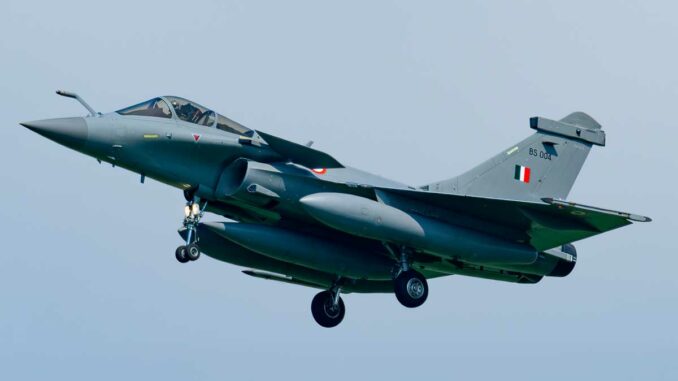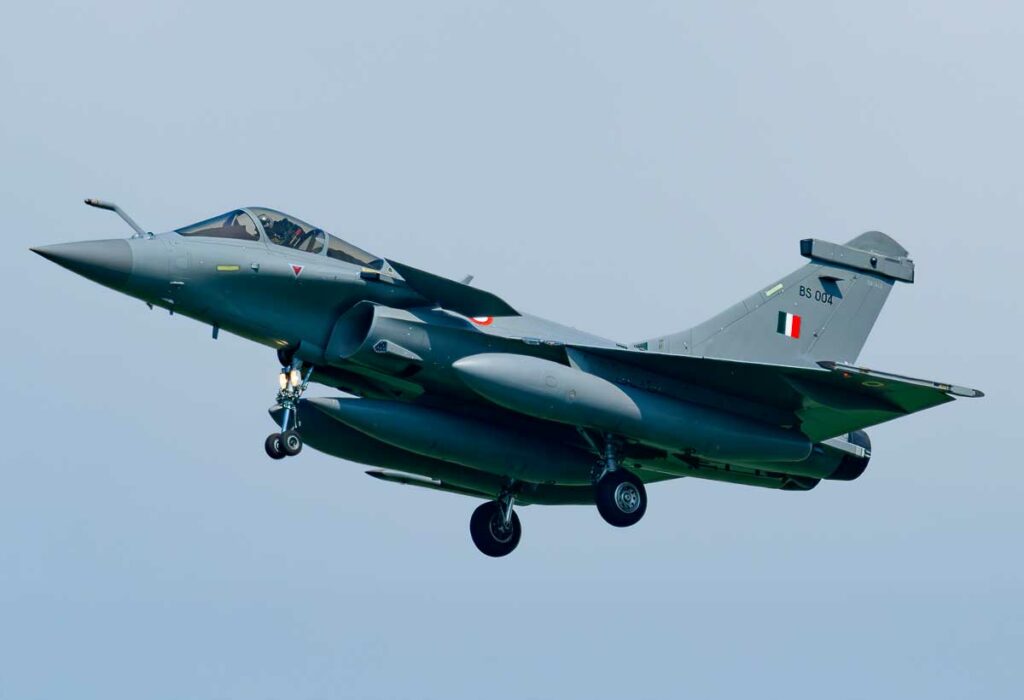
Three Indian Air Force Rafale fighter jets, previously claimed to have been shot down by Pakistan, will be present at the Cope India 2025 exercise: a strong signal of reliability and capability.
Summary
Three Indian Air Force Dassault Rafale aircraft, identified as BS-021, BS-022, and BS-027—which the Pakistan Air Force falsely claimed to have shot down during the May 2025 conflict (Operation Sindoor)—are registered to participate in the bilateral Cope India 2025 exercise organized with the United States in November. This selection attests to their full operational status and effectiveness in a contested environment. The IAF thus intends to demonstrate that its Rafales are participating in large-scale multinational dreams, while sending a clear message about the reliability of this platform. This event comes amid a crisis with Pakistan, where air engagements have been intense and controversial. From this perspective, the article first recounts the facts, recalls the allegations made in May, examines the importance of Cope India, and then analyzes the strategic consequences for the IAF’s fleet and credibility.
The context: conflict and allegations of losses
In May 2025, the Indian Air Force launched Operation Sindoor, aimed at striking nine suspected terrorist camps on Pakistani territory and in Pakistan-occupied territory. Several Pakistani sources then claimed to have shot down up to six Indian aircraft, including three identified Rafale jets—numbers BS001, BS021, BS022, and BS027. For their part, the Indian authorities admitted to aircraft losses but denied shooting down any Rafales. The dispute therefore centered on a key issue: the loss of a high-end platform, which would have tarnished the reputation of this generation of fighter jets. These allegations quickly fueled an information war between Islamabad and New Delhi. The fact that at least three Rafales were singled out (BS-021, BS-022, BS-027) — and that they are now engaged in an international exercise — illustrates that the IAF attributes to these aircraft an intact capacity to operate in complex contexts.
Confirmation of the commitment: Cope India 2025 and its challenges
The Cope India exercise is a high-level meeting between the Indian Air Force and the United States Air Force, aimed at strengthening interoperability, air combat techniques, and multi-role capabilities. For the edition scheduled for November 2025, the participation of the Rafale BS-021, BS-022, and BS-027 has a dual significance: on the one hand, it demonstrates that these aircraft are fully operational and available, and on the other hand, it serves as a strategic message to the region, particularly Pakistan, that the IAF has its most advanced platforms at its disposal without hindrance. The choice to include these three specific aircraft highlights that the IAF does not consider them to be weakened or unreliable. As a result, the notion of a “downed Rafale” is crumbling on an operational level—which undermines the impact of Pakistan’s claims. Finally, participation in a multilateral exercise means that these Rafales will operate in a demanding environment: allied systems, complex scenarios, combined missions, and reinforced air superiority tactics.
The symbol of a proven platform in a contested environment
By registering the Rafales in question for Cope India, the IAF is validating several objectives. First, the maintenance, logistics, and support chain for the Dassault platform appears to be fully functional—even after a period of tension and allegations. Second, participation demonstrates that the platform is considered reliable for large-scale missions, not just secondary tasks. Third, the message to allies and partners: India is equipping its squadrons with a 4th generation+ platform capable of integrating into international exercises. This is all the more important as India strengthens its air power posture in the face of neighbors with modern capabilities. Finally, the presence of the Rafale at Cope India is an indirect response to opposing narratives: it clarifies that the fleet is projection-capable and unaffected by unconfirmed losses.
Implications for the credibility of the IAF and the Rafale fleet
The issue of credibility is central. A confirmed loss of Rafale aircraft could have undermined the confidence of suppliers, allies, and the aviation industry. The fact that these three aircraft are being mobilized as visible elements in a major exercise restores that confidence. This effectively bolsters future acquisition programs (notably the MRFA program mentioned for more Rafales to come) and reassures manufacturers about long-term support options. Furthermore, on a diplomatic level, India is showing that it is not experiencing an “air credibility crisis,” but rather that it continues to deploy its assets. This stance will undoubtedly be closely observed by other countries, particularly in the context of its strategic partnerships with France, the United States, and other arms suppliers.

The effects on the supply chain and combat operations
Logistically, the full return to service of these Rafales means that all associated systems—maintenance, crew training, parts availability, wing infrastructure—are operational. This is essential to maintaining a high availability rate and organizing such a multinational exercise. Selecting these aircraft for an exercise requires that they be technically capable in terms of avionics, radar, tactical missiles, electronic warfare, and interoperability. All of this suggests that the IAF considers these jets to be fully capable of a high level of engagement. This also influences program maintenance planning, squadron division (each Rafale squadron has around 18 to 20 aircraft), and operational readiness for other missions—including those in a potential conflict zone.
Strategic lessons for India and South Asia
India finds itself in a complex strategic environment, with two neighbors possessing significant capabilities, Pakistan and China. The Rafale’s involvement in Cope India strengthens India’s posture in the region. It underscores that one of the key pillars of India’s strategy is rapid air force modernization, accompanied by increased interoperability with the United States. Added to this is the importance of the “credibility factor” in the face of adversarial claims: by showing that the Rafales are intact, the IAF reduces the impact of Pakistani allegations. In practice, this can influence air deterrence and planning for future contingencies. For defense analysts, this confirms that India is capable of flying its aircraft in a high-intensity environment while participating in allied exercises—an indirect deterrent message to any potential adversary.
The industrial and international cooperation perspective
The effective participation of the Rafale in Cope India also highlights Indian-French and Indian-American cooperation. For the manufacturer Dassault Aviation, this reinforces confidence in the exported Rafale model, particularly in India. It may open up opportunities in other markets or for additional deliveries to India. On the American side, the exercise reflects the rise of the IAF as a credible operational partner. Finally, for India, it confirms its ability to use its platforms in a multilateral setting, an essential element of its “more connected Indo-Pacific” policy. In other words, the Rafales are no longer simply symbols but operational components integrated into an allied network.
Looking to the future: challenges and prospects
Even amid congratulations for this participation, certain challenges remain. The IAF will need to maintain a high rate of Rafale availability, continue to improve crew training, ensure long-term logistical support, and oversee the evolution of integrated weapons systems (missiles, sensors, electronic warfare). In addition, the Cope India exercise will undoubtedly give rise to demanding scenarios: air superiority, penetration of enemy defenses, data sharing, and allied networking. The performance of the Rafale in this environment will be closely scrutinized. Finally, India will have to continue to manage perceptions related to its commitments with Pakistan—the fact that the Rafales were “allegedly shot down” remains a rallying point for Islamabad’s communications. The decision to have them participate helps to dispel this type of argument, but their real effectiveness will be measured by results, not just by their presence.
The Indian Rafales are therefore embarking on Cope India 2025 not only as participants, but as flying ambassadors of an air power policy. The message is clear: the fleet is intact, ready, and interoperable. It remains to be seen how they will be used in the exercise, and what the diplomatic and strategic reaction of the regional environment will be.
War Wings Daily is an independant magazine.